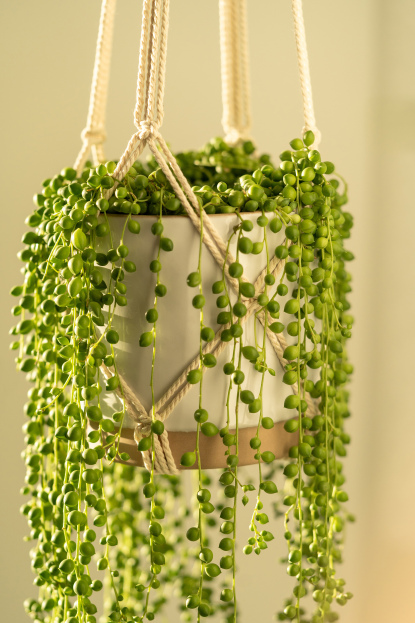
String of Pearls (Senecio rowleyanus) is an attractive trailing plant with round succulent leaves.
Placing this plant in in-direct sunlight is where they do best. Remember to not place them in direct sunlight as long exposure to direct light can damage its leaves.
Make sure the top of the pot gets enough light to avoid damp soil, root rot, pests, and plant damage. If your plant is in a hanging basket or somewhere that light is not reaching the soil on your plant, you can supplement with a grow light.
As with most succulents, the String of Pearls also prefer well-draining soil. Be sure to use a potting mix that is specifically for succulents/cacti.
This plant is also drought tolerant as their leaves can retain water for a long period of time. Due to this they do not need as frequent of a watering routine.
Allow the soil to dry out thoroughly between watering's to prevent root rot and other overwatering related issues. Pearls that look flat are a sign that the soil is too dry. Give it a good watering when needed but ensure to not to overwater them. When watering into a pot without drainage holes, be sure to discard any excess watering sitting at the bottom of your pot to prevent root rot or pests.
Feed your String of Pearls with a diluted organic houseplant fertilizer. You can feed them biweekly or monthly during their growing season. Ensure that during the fall and winter months that you stop fertilizing them, as they become dormant and should not be fed during this time.
This plant prefers cooler and more humid temperatures over the warmer temperatures that most succulents thrive in. Avoid any cold drafts from any windows or air conditioners. To increase the humidity you can run a humidifier in the room of the plant, or you can lightly mist their leaves to help promote humidity.
The "String of Pearls" plant (Senecio rowleyanus) is typically deemed harmful to pets if consumed. The ASPCA categorizes it as poisonous to both dogs and cats. If pets consume parts of this plant, they could exhibit signs like vomiting, diarrhea, excessive salivation, sluggishness, and other digestive problems. If you own pets, it's recommended to either place this plant beyond their reach or choose non-toxic alternatives.
Yes your String of Pearls can flower.
Parts of the stem on your plant may loose foliage or fall of due to the plants soil drying out too much at the top. String of Pearls have a delicate root system and if exposed to longer periods of dry soil then it may cause your plant to loose or have its foliage dry up. If you bottom water your plant, ensure to mist or water the top of your plants soil to ensure that its entire root system is saturated when watering.